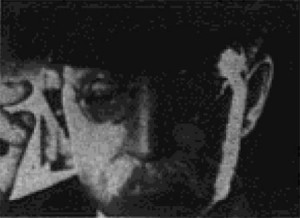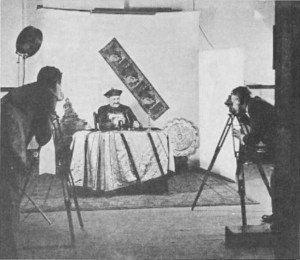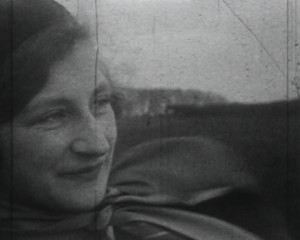"A German airman is boarding at a house in England. The landlady tells him about her daughter's death; she was killed in an air raid on her seventeenth birthday. As he hears the story, he remembers that day and that he was dropping bombs on the area. When he sees her portrait, he runs from the house and the landlady's son Rudolph runs after him. He chases him across the clifftops and the German sees a vision of the daughter. He tries to embrace her but stumbles and falls off the cliff. Rudolph also sees his sister, they laugh, embrace and he throws stones at the German who is clinging to a tree root. Rudolph's vision disappears and he runs down to rescue the German but he is already dead" (BFI online).
"Mr Terence L. Greenridge writes to tell me that the film “Afterwards”, for which he and his wife Nora [Pfeil] Greenridge, are jointly responsible, has been taken back for the sake of certain additions, previous for general release to amateur societies. Mr Terence Greenridge is better known in the amateur film movement as the first filmmaker in Oxford University, and as author of the recently published “Degenerate Oxford!” For some time he has been a leading light of the London A.C.A. Mr Terence Greenridge did the secondary jobs of “Afterwards”, such as scenarising, choosing locations, and working out camera angles. This film, which had a particularly successful premiere at the London A.C.A.’s public show, is not merely the London A.C.A.’s most ambitious production for 1930, but is also something rather new in cinematography, whether professional or amateur. It has something of that imaginative audacity for which I have already pleaded, and it is, very largely, the work of a woman."
"Telling Situations - In too many cases a film has to attempt to justify a conventional plot. In this case the plot makes the film. Nora Greenridge, who wrote the story, possesses a natural instinct for a telling situation: even when, as in this case, the theme came to her in a dream. In “Afterwards” there is nothing of the sentimental, conventional world of nine films out of ten, where the hero is never allowed to die unless it is obvious that life has not more to offer him. The good looking hero of “Afterwards” dies at the prime of life, full of vitality, and in “Afterwards” the dramatic conflict is between man’s muddle-headed kindliness and the precise retribution of the supernatural world: so precise that, on occasion, it can become cruelty. The film is not calculated to induce placid happiness in an audience, but rather to challenge them to think about the deeper problems of life. Treatment has been subordinated to theme. There is no stunting in this film. Camera-angles and backgrounds were selected in so far as they might elucidate the episode which was being pictured, and not for intrinsic excellences that they might posses in themselves. The beauty of the English countryside finds expression in “Afterwards”, but Nora Greenridge has utilised it in a purposeful manner, understanding how grim events become twice as grim, if they happen in beautiful surroundings."
“Happy Ever After - Nora Greenridge not only wrote the story and directed its production, but played a part, to quote one of the critics, “with sylph-like grace”. Mrs Greenridge, or Nora Pfeil as she used to be, is an attractive blonde and has played several leading roles in London A.C.A. productions. She has also won many awards in scenario competitions. She became engaged to Terence Greenridge a quarter of the way through the production, and halfway through the production their marriage took place. Now they have a house called “Afterwards”—a happy and true modern version of the age-old fairy-tale ending" (M.A.L.B. 1931, 9).
"One of the films being shown [as part of the All-English Amateur Film Week] has been referred to as the most ambitious production of 1930. Produced by Terence Greenridge, better known as an author, directed by Miss Nora Pfeil, who has since become Mrs Greenridge, “Afterwards” is certainly a film none should miss. Plots should not be given away in advance, so let it be said that a German Professor came to England in 1928 on a geological holiday. He settled down with an English family, the daughter of which had been killed in an air-raid over London ten years previously, and the son rendered neurotic. The family generally “took to” the German, who was a sociable enough fellow. They forgot the war, but as the tenth anniversary drew near—It is a film well worth seeing" (Anon 1931, 9).
"The Ages of Manby Dr. Wallace Shaw, a consistent winner, of Jamaica, N.Y. In 26 minutes of color, make-up and fine filming technique we see the phases of a man's life unfold...and fold. Being a doctor, Wally had access to some unusual location shots that "hook" you right from the start and carry you to a very revealing ending. The film gives food for thought with its philosophy and its unusual approach," PSA Journal, Mar. 1970, 43.
"A young man collects his girlfriend in his car, visits the Meteor Golf Club then drives into the country. They swim with a lido, enjoy the beach, picnic, then drive into Glasgow at sunset." (EAFA Database)
"This proved to be an unusual serio-comedy, telling of a restless young husband and how he was cured. It was very well acted by Alfred Fontana as the husband, Margaret Ervin as the vamp, Anne Howe, and Beatrice Traendly as the wife. The directon of Russell T. Ervin Jr. was remarkably good, revealing an unusual facility for telling a story concisely and quickly. Then too, he understood how to cover any histrionic imperfections of his cast. 'And How!' is a suprisingly neat amateur film" Photoplay, June. 1928, 66
"An anti-war film which portrays the effect of war on its participants by presenting a dramatization in which a Vietnam veteran attempts to assassinate the President" via WorldCat.

"In Backfire we find an elderly gentleman intent on planting a bomb which, if it goes off as planned, will make his future a bit more easy to take, but from the title of the picture you may assume things don't go quite according to plan. The old fellow does a fine job of acting, and he is capable of holding the viewer's attention" PSA Journal, Aug. 1967, 36.

Promotes the all-round activities of YMCA work and their relationship to character-building. Kenyon, a one-time YMCA athlete, has "fallen into evil companionship" and become addicted to cocaine. Under the control of Chinese underworld kingpin Chang Yat, he aids in the kidnapping of a white girl. Afterwards, he discovers his old "Y" pin and recalls the role of YMCA athletics in shaping his character. Seized with remorse, he overpowers Chang Yat and helps the girl escape. Later, Kenyon returns to the YMCA. (D.J. Duffy, condensed from "Y.M.C.A. Cinema Club Produces Smart Film," Toronto Daily Star, May 31, 1930, p. 30.)
Film was sponsored or co-produced by the Central Y.M.C.A. of Toronto, and written by the club's secretary, H.G. McKinley.

"Amateur filmmaker H.A.V. Bulleid spins a web of intrigue in a feature-length tale that pits British secret servicemen against Russian agents desperate to obtain a top secret document. When Agent Malloon (Michael Kitchin) is given the task of protecting top-secret plans of utmost international importance, Jim Weston (Stephen Bostock) and Vernon Stone (Sinclair Loutit) - Malloon's closest friends - are busy competing for the affections of his sister, Jill (Carrie Hopkinson). Seemingly a hapless idiot, Weston is in fact a secret service detective, acting the fool in order to dupe Stone, a Russian super-spy. And when Stone and his Russian associates beat Malloon unconscious and steal the documents, it is up to Weston to lead the charge as car chases and deadly fist fights ensue. But can Jim Weston retrieve the papers, save the nation and - most importantly - finally conquer Jill Malloon's heart?" (EAFA Database).
"Al Londema's 'The Black Satchel,' is a pretentious photoplaylet in 8mm color, showing good camera work and direction." American Cinematographer, May. 1952, 224.
Total Pages: 12